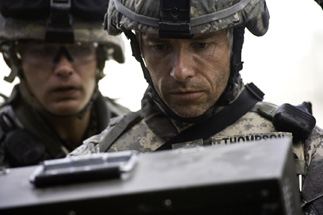Movie Review: The Hurt Locker
By Matthew Huntley
July 14, 2009
BoxOfficeProphets.com

The film is ultimately anti-war for all the usual reasons, but its main focus is the crippling effects war has on young men's minds. Once you've been in battle, the film argues, everything else can seem small and inconsequential by comparison, which, if you think about it, is tragic because young soldiers wind up hoping for violence and devastation.
Through a series of distinguishable vignettes, director Kathryn Bigelow has crafted one of the most intense films of the year. Not only is it a tour de force on a technical level, but it also contains a story that envelops and convinces us to care about its characters. On paper, a lot of its scenes should be similar, abut Bigelow brings suspense and intrigue to each and every one of them. This is a film whose raw materials and construction all play an especially important role together, from the sound, photography and special effects to the direction and editing. The result is something truly effective as it places us directly in the center of the action. I haven't felt this involved in a war picture since Ridley Scott's Black Hawk Down.
At the height of the Iraq War (the film was shot in and around the 2007 surge in Jordan), an American EOD (Explosive Ordinance Disposal) team routinely diffuses bombs and struggles with the daily conflicts of their surroundings. Violence and disorder are so commonplace that we, the viewers, can only imagine what it's like to be a soldier in this time and place. Such an experience can probably never be fully realized on film, but Bigelow comes about as close as any filmmaker can. I'm sure much of the footage was taken right off the streets of the shooting locations and there are particular shots, like a one-legged cat limping across the street, that are brutal to watch but which raise the level of realism.
There is no traditional plot to follow. Many of the film's scenes and situations — be it a taxi driver going where he's not supposed to; a wisecracking boy selling pirated DVDs; suspicious men gazing down from windows; a fatal, unforeseen attack in the middle of the desert—are random and serve to place us in the middle of a hellish and irrational environment. Bigelow and screenwriter Mark Boal also teach us specific things about being a soldier, such as having to clean off blood-stained bullets so they'll fire correctly.
The EOD team is led by Sergeant William James (Jeremy Renner), a cocky and fearless technician who would probably diffuse bombs all day if he could. Why? Because it's what he's good at, it's what sets him apart from his fellow soldiers and, for him, it's an unparalleled experience. James is obsessive about finding a purpose to his job and he cares little about protocol, which upsets the men he leads — Sergeant Sanborn (Anthony Mackie) and Specialist Eldridge (Brian Geraghty). They're the more "traditional" soldier types because they yearn to leave Iraq when their rotation is complete. The curious thing about James is he wants to stay, despite having a wife and baby. We feel sorry for him because of the way war has corrupted him.
Renner, Mackie and Geraghty are all very effective in their roles and their performances are even more impressive because they don't have a traditional formula to work with. For James, Sanborn and Eldridge, everyday is a new conflict and they're at a loss for a common enemy or purpose. All they know, and all we know, is they hate where they are, as do we, which makes it easy for us to hope they make it out alive.
Ultimately, what makes The Hurt Locker such a memorable and well conceived film is its ability to place us in another world, a world that happens to be real. Bigelow doesn't hand out rational meanings or make any of the deaths or survivals serve the plot; she's loyal to the film's reality and she makes us feel it. What's also interesting is how the film entertains and excites us. With its piercing sound and visuals, the action has a visceral effect on us, but not the kind that makes us want to experience it action first-hand. One thing we're not meant to be is envious of these soldiers.
The Hurt Locker is a masterful achievement, both technically and narratively. The filmmakers literally shake the ground of the theater we sit in and provide a story and characters that touch us emotionally. The most important thing the film does, and which we leaves the greatest impression, is to allow us to understand its world and the people who try to survive in it. We gain an insight and perspective of a place and state of mind that most of us only read or hear about through testimonials. At its core, it's a human story about young men trying to find their way through chaos, and from the very first scene, we feel we know these men and understand what they go through.